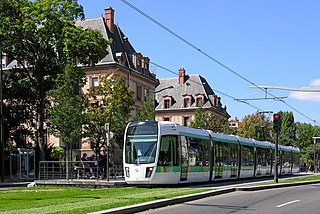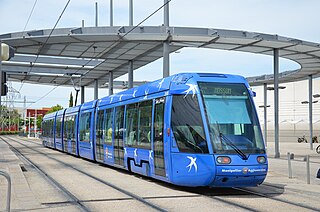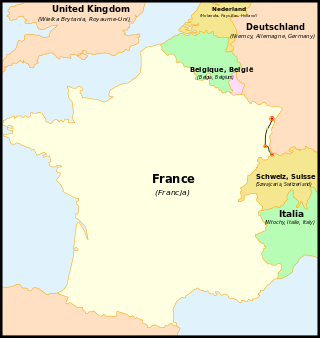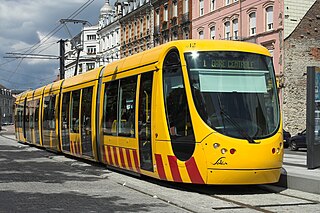
Mulhouse is a French city of the European Collectivity of Alsace. It is near the France–Switzerland border and France–Germany border. It is the largest city in Haut-Rhin and second largest in Alsace after Strasbourg.

Thann is a commune in the northeastern French department of Haut-Rhin, in Grand Est. It is the sous-préfecture of the arrondissement of Thann-Guebwiller and part of the canton of Cernay. Its inhabitants are known as Thannois.

The Île-de-France tramways is a network of modern tram lines in the Île-de-France region of France. Fourteen lines are currently operational, with extensions and additional lines in both construction and planning stages. Although the system mainly runs in the suburban regions of Paris, lines T3a and T3b run entirely within Paris city limits, while lines T2 and T9 start their routes within Paris' borders. While lines operate independently of each other and are generally unconnected, some connections do exist: between lines T2 and T3a, T3a and T3b, T1 and T5, T1 and T8, T8 and T11 Express, T3a and T9 and T6 and T10. However, the final design of the entire planned tram network is fairly integrated.

TER Alsace was the regional rail network serving the région of Alsace, eastern France. In 2016 it was merged into the new TER Grand Est.

The Bordeaux tramway network consists of four lines serving the city of Bordeaux in Nouvelle-Aquitaine in southwestern France. The system has a route length of 77.5 kilometres (48.2 mi), serving a total of 133 tram stops.

The X73500 is a diesel multiple unit (DMU) train type operated by SNCF. They were built between 1999 and 2004 by Alstom.

The Lyon tramway comprises eight lines, seven lines operated by TCL and one by Rhônexpress, in the city of Lyon, France. The original tramway network in Lyon was developed in 1879; the modern network started operation in 2001.

Lutterbach is a commune in the Haut-Rhin department in Alsace in north-eastern France. It forms part of the Mulhouse Alsace Agglomération, the inter-communal local government body for the Mulhouse conurbation.

The Montpellier tramway is a four-line tramway system in the city of Montpellier in Occitanie, France. The tramway is owned by the Montpellier Méditerranée Métropole, and is operated by the Transports de l'agglomération de Montpellier (TAM) authority.

Strasbourg-Ville station is the main railway station in the city of Strasbourg, Bas-Rhin, France. It is the eastern terminus of the Paris-Est–Strasbourg-Ville railway. The current core building, an example of historicist architecture of the Wilhelminian period, replaced a previous station inaugurated in 1852, later turned into a covered market and ultimately demolished.
With nearly 24 million passengers in 2023, Strasbourg-Ville is one of the busiest railway stations in France outside of the Île-de-France.

A battery electric multiple unit (BEMU), battery electric railcar or accumulator railcar is an electrically driven multiple unit or railcar whose energy is derived from rechargeable batteries driving the traction motors.

Pessac is a railway station in Pessac, a western suburb of Bordeaux, Nouvelle-Aquitaine, France. The station is located on the Bordeaux–Irun railway line. The station is served by TER (local) services operated by SNCF. The Pessac Centre tram stop of the Bordeaux tramway is adjacent to the railway station, with direct access between station and tram stop platforms.

The Gare de Mulhouse-Ville, also known as Gare Centrale, is the main railway station in the city of Mulhouse, Haut-Rhin, France. It is the eastern terminus of the Paris-Est–Mulhouse-Ville railway.

The railway from Strasbourg to Basel is a French and Swiss 141.3-kilometre long railway line. It is used for passenger and freight traffic. The railway was opened in 1840–1844. It was the first railway line to serve Switzerland.

Soléa is a public transport operator in the French city of Mulhouse. Under contract to the Mulhouse Alsace Agglomération, it operates the city's bus network and three of the lines of the city's tram network. It also jointly operates, with the French national rail operator SNCF, the city's fourth tram line, a tram-train service.

Rosa Parks station is a railway station in the 19th arrondissement of Paris, France near the Porte d'Aubervilliers. It is on the RER network, and also has a tram stop. The station opened on 13 December 2015, and bears the name of American civil rights activist Rosa Parks.

The Gare de Sarreguemines is a railway station near the French/German border on the Haguenau–Hargarten-Falck and the Saarbrücken–Sarreguemines lines, located in the town of Sarreguemines in the French department of Moselle.

Gare de Dijon-Porte-Neuve is a French train station located at Junot Avenue in Dijon. It is in the Côte-d'Or department, within France's Bourgogne-Franche-Comté region. Gare de Dijon-Porte-Neuve is the secondary station for the city of Dijon, with the primary station being Gare de Dijon-Ville. TER trains take six minutes to go from one station to the other, crossing the city. Gare de Dijon-Porte-Neuve is an SNCF train station, served by TER Bourgogne-Franche-Comté trains.

The Müllheim–Mulhouse railway is a 22.140 km-long single-track railway, crossing the Upper Rhine between Baden, Germany and Alsace, France. The whole line is electrified with catenary, using different national electrification standards on either side of the Rhine. It branches off the Rhine Valley Railway (Rheintalbahn) in Müllheim and it connects with the Paris–Mulhouse railway and the Strasbourg–Basel railway in Mulhouse.

The Z 23000 was a type of passenger train used by the Compagnie du Chemin de Fer Métropolitain de Paris (CMP).























